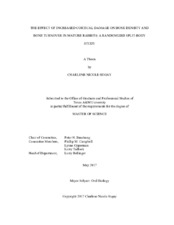| dc.contributor.advisor | Buschang, Peter | |
| dc.creator | Sugay, Charlene Nicole | |
| dc.date.accessioned | 2017-08-21T14:33:45Z | |
| dc.date.available | 2019-05-01T06:09:30Z | |
| dc.date.created | 2017-05 | |
| dc.date.issued | 2017-02-13 | |
| dc.date.submitted | May 2017 | |
| dc.identifier.uri | https://hdl.handle.net/1969.1/161328 | |
| dc.description.abstract | The purpose of this study was to investigate the biological changes in bone density and bone modeling of the cortical bone when increasing the amount of cortical damage.
Using a split body design, rabbit tibias were randomly allocated into a control group with one osteoperforation (OP) or experimental group with four OPs through the cortical bone. Two weeks prior to sacrifice. µCT, Vickers Hardness microindentation, and histologic analyses were performed.
The experimental bone was significantly less dense than the control bone up to 2.0 mm away from the OPs after 2 weeks of healing. The Vickers hardness of the control bone was significantly harder than the experimental bone up to 3.3 mm away from the OPs. The H&E sections of cortical bone showed greater amounts of woven bone within the OP site in the control specimen than in the experimental specimen after 2 weeks of healing while the experimental group had a greater amount of unmineralized fibrous tissue within the OP site. Added tissue was found on the periosteal and endosteal surfaces in both samples. The control group primarily had added woven bone while the experimental group primarily had added fibrous tissue, indicating an earlier stage of healing in the group with four OPs. There were areas of acellularity directly adjacent to the OPs in almost all of the control and experimental samples, which extended up to 0.875 mm away from the OPs. TRAP staining indicated greater osteoclastic activity in the experimental group than the control group up to 1.0 mm away from the OPs.
In conclusion, greater cortical damage resulted in adjacent cortical bone that was less dense, less hard and had a higher degree of osteoclastic activity. The rate of healing was also slower with greater damage. | en |
| dc.format.mimetype | application/pdf | |
| dc.language.iso | en | |
| dc.subject | corticotomy | en |
| dc.subject | bone | en |
| dc.subject | cortical bone | en |
| dc.subject | bone density | en |
| dc.subject | microhardness | en |
| dc.subject | rabbits | en |
| dc.subject | bone remodeling | en |
| dc.subject | bone healing | en |
| dc.subject | orthodontics | en |
| dc.subject | osteoclasts | en |
| dc.subject | osteoperforation | en |
| dc.subject | long bone | en |
| dc.subject | tibia | en |
| dc.subject | bone damage | en |
| dc.subject | regional acceleratory phenomenon | en |
| dc.subject | RAP | en |
| dc.title | The Effect of Increased Cortical Damage on Bone Density and Bone Turnover in Mature Rabbits: A Randomized Split-Body Study | en |
| dc.type | Thesis | en |
| thesis.degree.department | College of Dentistry | en |
| thesis.degree.discipline | Oral Biology | en |
| thesis.degree.grantor | Texas A & M University | en |
| thesis.degree.name | Master of Science | en |
| thesis.degree.level | Masters | en |
| dc.contributor.committeeMember | Campbell, Phillip | |
| dc.contributor.committeeMember | Opperman, Lynne | |
| dc.contributor.committeeMember | Tadlock, Larry | |
| dc.type.material | text | en |
| dc.date.updated | 2017-08-21T14:33:46Z | |
| local.embargo.terms | 2019-05-01 | |
| local.etdauthor.orcid | 0000-0001-7305-7989 | |


